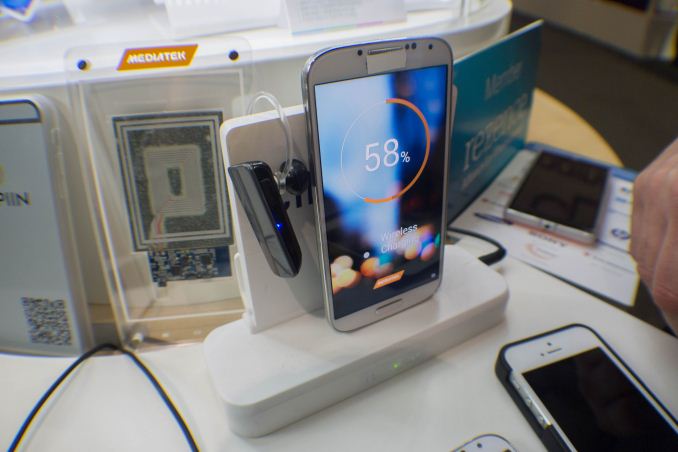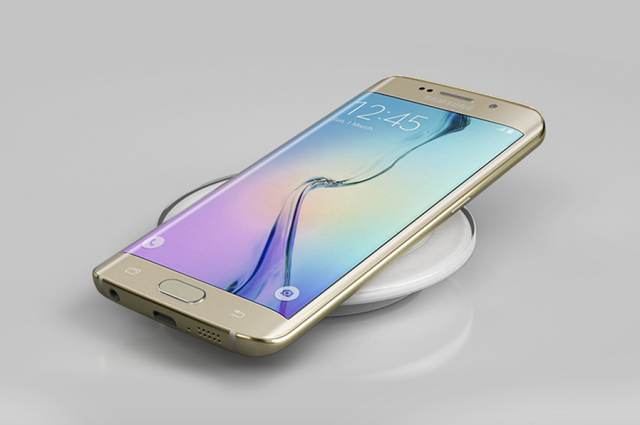The State of Wireless Charging Standards in Mobile
by Andrei Frumusanu on April 2, 2015 8:00 AM EST
Wireless charging in the mobile space has seen its debut almost 6 years ago now with the introduction of the Palm Touchstone. Back in the day, this was quite a revolutionary advancement for mobile devices and I still remember the discussion on how wireless charging would be the future. Six years later, I have yet to own a wireless charger or know somebody who uses one. Analyst prediction of quick adoption failed to materialize and the industry is still trying to consolidate a universal charging standard that would be compatible across all devices. While Palm sparked the wireless charging wars back in 2009, it took device manufacturers many more years before we reached (or have yet to reach) a level of adoption such that the average consumer would be able to confidently use the technology as a de-facto everyday way of charging their devices in the same way that microUSB has.
With the advent of Qi and PMA as opposing and incompatible charger technologies the industry saw a period of uncertainty over which standard would finally make it into the mainstream. In the end, it might be neither, but before we delve into the future, let’s have a look at how wireless charging has evolved over the last few years and how the mechanisms actually work.
A Timeline of Events and Standards
While Palm was first to introduce a wireless charger in the Palm Pre in form of the Touchstone, this was a proprietary standard which wasn’t adopted by other vendors. In fact, while Palm announced and presented the Touchstone at CES 2009, a small group of manufacturers including Logitech, Philips, Sanyo and Texas Instruments gathered around in December of 2008 to form the Wireless Power Consortium, or WPC.
The WPC released later in 2009 the first specification the Qi 1.0 which would become the first proper open wireless charging standard for low power devices. “Qi”, pronounced “chee”, is named after the same Chinese word for “life force” or “energy flow”. In the following months and years the WPC saw a lot of companies adopt the standard and join as members of the consortium. The big names such as LG, Motorola, HTC, Samsung, Sony and Nokia were on board and at this point it looked like Qi was on its way to become the de-facto standard for large scale adoption.
The Nokia Lumia 820 and 920, and more importantly the Nexus 4 were the first devices which introduced Qi charging built-in by default by the manufacturers and were available towards the end of 2012. The biggest enabler of wireless charging though was probably Samsung – starting with the Galaxy S3, Samsung integrated wireless charging capability into their PMICs and exposed on the back of the phones not only pins for the charger coils, but also power contacts which we’ll come back to later. Cheap charger coils that could be added between the battery and cover and attached to the wireless charging pins meant that users could quickly experience wireless charging without too great of an investment.
While the WPC seemed to have won the standards-race with an early start and rising adoption in 2012, the same year the Power Matters Alliance (PMA) was formed as a competing standard. While the WPC seems to have concentrated in the mobile space, the PMA aims to be a more generic standard for other use-cases. Starbuck’s June 2014 announcement of the adoption of PMA notoriously surprised consumers as PMA had seen very little adoption by the market versus Qi. PMA seems to continue to gain adoption by sheer brute force introduction of North American outlets such as McDonalds and Starbucks but faced the problem of needing special charging adapters as no device was yet compatible with the new standard.
While both the WPC and PMA make use of inductive charging technology, a third standard appeared in early 2012 in the form of “Rezence”. The standard is developed by the Alliance for Wireless Power (A4WP). Here the power transfer technology is based on magnetic resonance instead of electromagnetic induction. Rezence sees support of some big companies such as Intel, Broadcom, Qualcomm and Samsung and promises a true alternative to induction charging that solves many of the problems faced with Qi and Powermat (PMA) solutions.
In January 2015 things were shook up again as the PMA and A4WP announced a merger of the two alliances. The merger aims to consolidate the swath of charging standards. While the merger won’t be finalized until June 30th 2015 and things could still change till then, what this means in practice is that Rezence will be seeing a much faster and larger adoption than anticipated through boost of PMA members.
At the time of writing the A4WP has a published 122 members, PMA 68 and the WPC 213 companies.
While Rezence seems to be the most promising candidate technology-wise to being adopted as the “USB of wireless charging” in the distant future, equipment manufacturers will first see the introduction of dual-and tri-standard compatible devices. The Galaxy S6 was one of the first devices to include both Qi and Powermat compatible charging built-in, it still lacks Rezence charging capability. What I expect for future devices though is cross-standard compatibility with help of adoption of solutions which support both inductive and resonance charging.
At MWC 2015 we’ve seen the demonstration of a slew of such solutions by for example MediaTek, Broadcomm and others. It is clear that manufacturers are going for multi-standard compliant end-devices in the future, and it’s the ecosystem around the charging stations which will decide on how things will evolve in the future.












90 Comments
View All Comments
blanarahul - Thursday, April 2, 2015 - link
The biggest problem with wireless charging for me is significant power efficiency losses, additional heating up and hence reduced lifetime of smartphone batteries which can't be replaced, thicker phones and (not completely sure) slower charging. It's simply not worth the 2 seconds it takes to remove/insert the cord from the phone.Spoogie - Thursday, April 2, 2015 - link
But it's never really 2 seconds, is it.blanarahul - Thursday, April 2, 2015 - link
With Micro USB Type-C it will be. Short distance wireless charging is worthless to me. I'd rather have the extra space be spent on putting larger batteries.lilmoe - Thursday, April 2, 2015 - link
I think Spoogie meant that it's not only about "connecting" your charging cable (regardless of type). Taking out your charger and looking for a free socket can prove to be hassle.That said, I agree with you. I'd "prefer" simplifying the internal design of the device (making repairs easier) and installing a beefier battery instead of wireless charging. But having both does have its benefits.
My real problem with wireless charging on the go is that your device needs to be stationary, ie: you don't have the convenience of using your device semi-freely like you would when its tethered with a fairly long cable. It's only charging when you're generally not using the device, unless you have a bluetooth or wired headset. You "solve" an inconvenience just to be faced with others.
nathanddrews - Thursday, April 2, 2015 - link
We use wireless chargers mostly because the USB ports are failing (wear and tear). $20 Qi chargers are cheaper than new phones. I'll be happier once we get whole-home wireless power transmission.blanarahul - Thursday, April 2, 2015 - link
I can't wait to see the ridiculous SAR/(or it's wireless power equivalent) values wreak havoc on your nervous system when you switch to whole home wireless power.Lord of the Bored - Friday, April 3, 2015 - link
Spoilers: Those magnetic fields wireless power connectors use? The ones induced by alternating current flow through a wire? They're ALREADY being generated by every electrified wire in your home. If wireless power was going to fry your brains, we'd already be dead.(Tangentally, electromagnetic fields and RF radiation are fundamentally different beasts and not really comparable like that. Yes, I did look up SAR to figure out what the hey you were talking about.)
Fortunately, aside from it not actually being an issue, magnetic fields fall off rapidly with distance. That's why inductive power connections require very short distances. You may remember Apple used to use inductive power connectors on their laptops, and you still had to run a cable from the charger to the computer anyways.
Coincidentally, that falloff is ALSO why whole-house wireless power isn't likely to go anywhere. Since you have to run cords from your devices to your power outlets ANYWAYS, you may as well keep using the same dead-simple, cheap to manufacture "legacy" power connector you always have. It was a problem in Nikola Tesla's time, and it's a problem in our's as well. Physics is a real drag sometimes.
JonnyDough - Saturday, April 4, 2015 - link
Not only are we polluting ourselves with radiation, but other creatures such as bees are supposedly being interfered with as well. Cancer is at an all time high, despite the lowering of chemical pollutants in industry and fewer smokers.jospoortvliet - Sunday, April 5, 2015 - link
try using logic here for a sec. People die, right? I mean nobody can live forever. There is a bunch of things you can die off. Starting with war and murder, then bacterial, virus and parasitic infections. What happens if you eliminate most of that? The next in line becomes the most killing. Cancer. but in places with war and bad health care, there is still 'no Denver's because the other stuff kills people. despite them having mobile phones and electricity.As usual, conspiracy theories require actually more fantastic things to be true than reality... I'm sure there is a theory you have that explains all I said - but it will be nonsense.
omems - Saturday, April 11, 2015 - link
jospoortvliet is spot on. now that we're not dying from polio and the flu, we can die from heart disease and cancer. here's some actual data, excerpted from the NEJM.http://www.businessinsider.com/leading-causes-of-d...
if you have access, the original article has a good interactive chart that might be more intuitive.